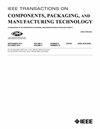封装低损耗MISL带通滤波器与通用混合耦合电路模型
IF 3
3区 工程技术
Q2 ENGINEERING, ELECTRICAL & ELECTRONIC
IEEE Transactions on Components, Packaging and Manufacturing Technology
Pub Date : 2025-03-29
DOI:10.1109/TCPMT.2025.3574813
引用次数: 0
摘要
在本文中,我们展示了使用两种类型的耦合线结构和多层金属集成悬索线(MISL)技术的低损耗带通滤波器(bpf)。此外,我们还介绍了一种新的电路模型,该模型为混合电与磁耦合bpf中传输零(TZs)的发生提供了直接和通用的解释。本文的结构如下。首先,我们引入了一个新的等效电路模型,准确地解释了如何通过混合耦合结构产生多个TZs。同时,利用该模型从理论上解释了平坦群延迟产生的原因。其次,我们提供了两个具体的设计示例,展示了放置TZs的灵活性。这些例子表明,TZs可以位于通带的右侧或两侧。最后,我们用MISL实现了所有建议的bpf。我们进行了模拟和测量,以验证所提出的理论和设计技术在实现的bpf上的有效性。仿真和测试结果证实,基于MISL技术设计的滤波器不仅易于制造,而且具有非常紧凑的尺寸和低损耗。本文章由计算机程序翻译,如有差异,请以英文原文为准。
Packaged Low-Loss MISL Bandpass Filters With General Mixed-Coupling Circuit Model
In this article, we demonstrate low-loss bandpass filters (BPFs) using two types of coupled-line structures with multilayer metal-integrated suspended line (MISL) technology. In addition, we introduce a novel circuit model that offers a straightforward and general explanation for the occurrence of transmission zeros (TZs) in mixed electric and magnetic (mixed-EM) coupling BPFs. The structure of this article is as follows. First, we introduce a new equivalent circuit model that accurately explains how multiple TZs are generated through mixed-coupling structures. At the same time, the proposed model is used to theoretically explain the cause of flat group delay. Second, we provide two specific design examples that demonstrate the flexibility in placing TZs. These examples show that TZs can be located on the right or both sides of the passband. Finally, we implement all the proposed BPFs with MISL. We conduct simulations and measurements to validate the effectiveness of the proposed theory and design techniques on the implemented BPFs. The results from both the simulations and tests confirm that filters designed based on MISL technology not only offer ease of fabrication but also possess very compact sizes with low losses.
求助全文
通过发布文献求助,成功后即可免费获取论文全文。
去求助
来源期刊

IEEE Transactions on Components, Packaging and Manufacturing Technology
ENGINEERING, MANUFACTURING-ENGINEERING, ELECTRICAL & ELECTRONIC
CiteScore
4.70
自引率
13.60%
发文量
203
审稿时长
3 months
期刊介绍:
IEEE Transactions on Components, Packaging, and Manufacturing Technology publishes research and application articles on modeling, design, building blocks, technical infrastructure, and analysis underpinning electronic, photonic and MEMS packaging, in addition to new developments in passive components, electrical contacts and connectors, thermal management, and device reliability; as well as the manufacture of electronics parts and assemblies, with broad coverage of design, factory modeling, assembly methods, quality, product robustness, and design-for-environment.
 求助内容:
求助内容: 应助结果提醒方式:
应助结果提醒方式:


